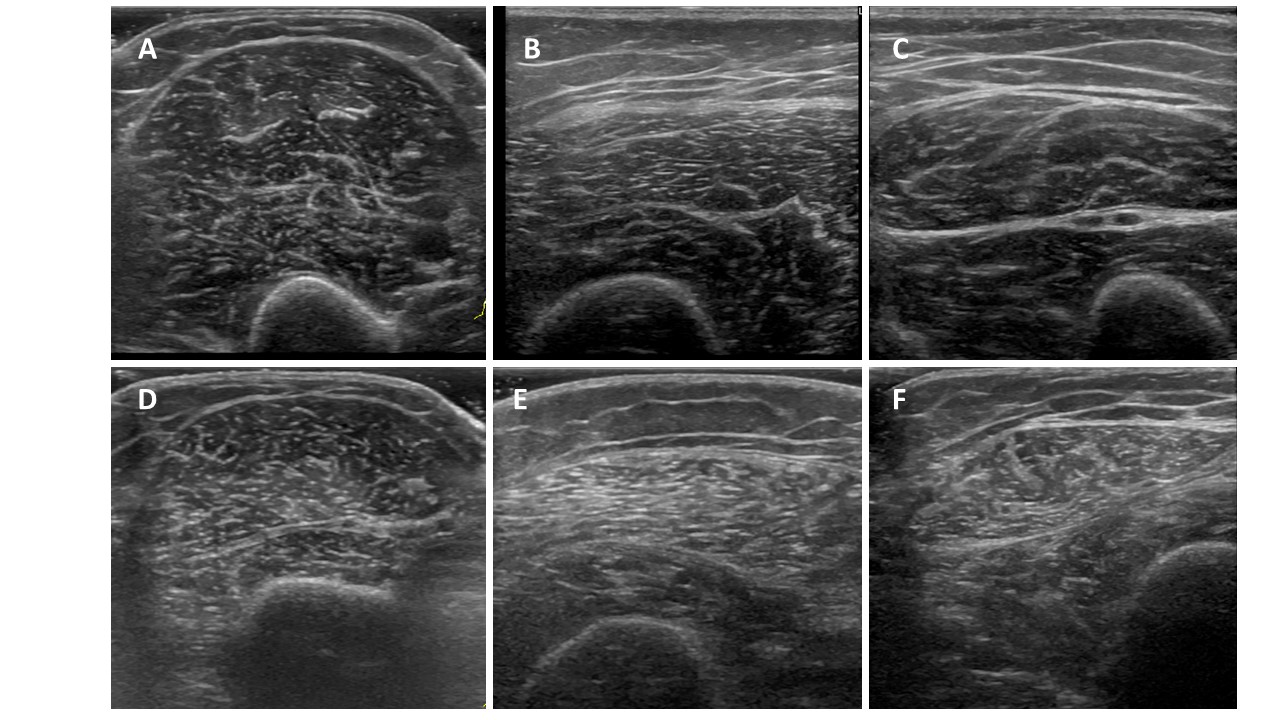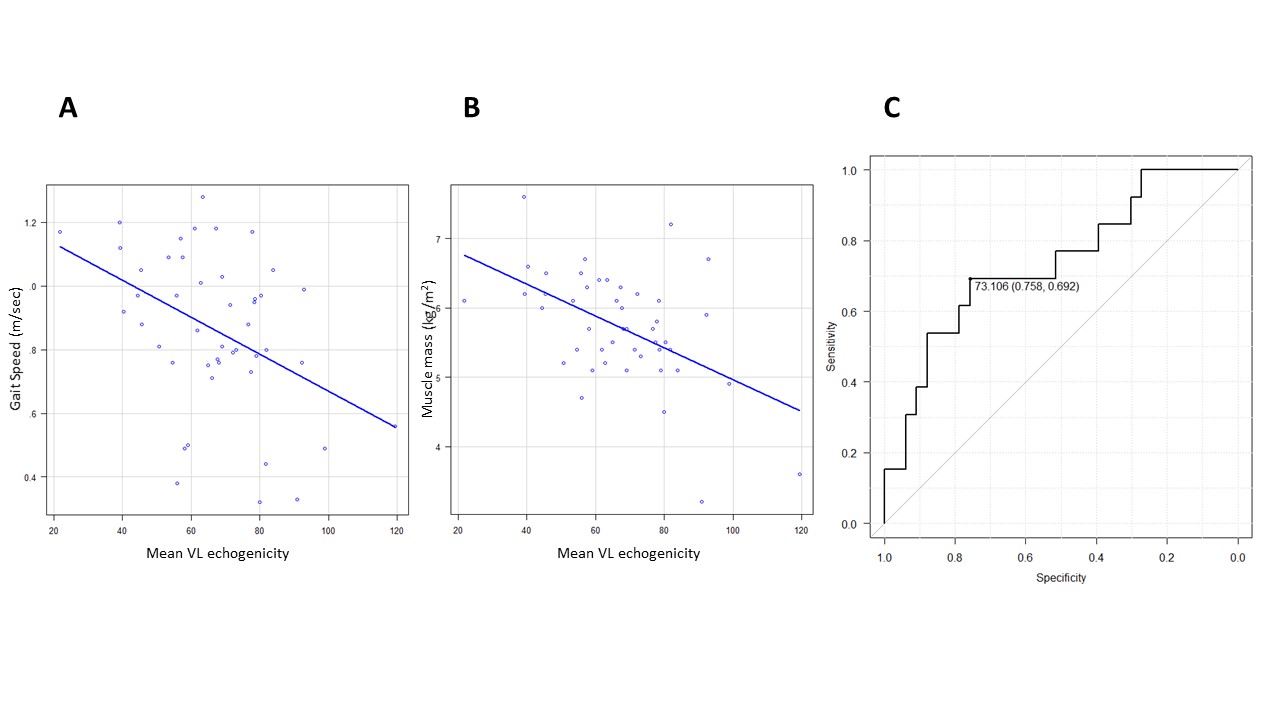Session Information
Session Type: Poster Session D
Session Time: 9:00AM-11:00AM
Background/Purpose: Sarcopenia, the age-related loss of muscle mass and function, is associated with numerous risk factors, including rheumatoid arthritis (RA). Although standard diagnostic tool for sarcopenia include dual-energy X-ray absorptiometry and bioelectrical impedance analysis (BIA), ultrasound (US) has a unique advantage to measure muscle quantity as well as muscle quality. Muscle echogenicity reflect intramuscular lipids and fibrosis, and it can be used as a marker of muscle quality. We sought to determine usefulness of US in discriminating patients with RA with sarcopenia from those without. We also assessed correlation between US echogenicity and various clinical measures of physical function and muscle volume.
Methods: 50 female patients with RA, aged 50 years or older, who fulfilled 2010 ACR/EULAR RA Classification Criteria were recruited and cross-sectionally studied. Clinical parameters such as age, BMI, CDAI, pharmacological treatments including corticosteroid and biologics, as well as comorbidities such as diabetes mellitus were assessed. Diagnosis of sarcopenia was based on 2019 updated Asian Working Group for Sarcopenia definition. Because handgrip test is often difficult for RA patients, chair-stand test was selected as primary assessment tool of physical function. BIA was used for the measurement of muscle volume. For US analysis, we used LOGIQ S8 (GE, USA; linear-array transducer) equipment. Cross sectional images of biceps brachii (BB), vastus lateralis (VL), and rectus femoris (RF) were obtained at predetermined position bilaterally. Mean US echogenicity was then calculated. On measuring US echogenicity, regions of interest were manually drawn by using ImageJ. All statistical analyses were performed using EZR, a graphical user interface for R. The p value of < 0.05 was determined as the cutoff for statistical significance.
Results: Mean age was 69.7 ± 7.23. 14 patients (28 %) were diagnosed as sarcopenia. 34 patients (68%) were positive for anti-CCP antibody. Age, disease duration, SARC-F, CDAI, current biologics use were significantly associated with presence of sarcopenia. Patients with sarcopenia had significantly increased US echogenicity of VL compared to those without (78.4 ± 18.15 vs 62.7 ± 16.05, p = 0.006). US echogenicity of VL showed the area under the ROC curve of 0.737 (95% CI, 0.569 – 0.904). In addition, US echogenicity showed significant negative correlation between gait speed (r = -0.507, p = 0.0003) and muscle volume (r = -0.423, p = 0.003).
Conclusion: US echogenicity of VL was useful in discriminating the RA patients with sarcopenia from those without. In addition, it showed significant correlation with both muscle volume and physical function. We suggest muscle US can be used as an assessment tool of sarcopenia in patients with RA and further studies incorporating more patients and longitudinal follow up would be needed.
 Table 1. Clinical and imaging features of RA patients with or without sarcopenia. Abbreviation. ACPA: anti-citrullinated peptide antibodies. BMI: body-mass index. CS: corticosteroid. RF: rheumatoid factor.
Table 1. Clinical and imaging features of RA patients with or without sarcopenia. Abbreviation. ACPA: anti-citrullinated peptide antibodies. BMI: body-mass index. CS: corticosteroid. RF: rheumatoid factor.
 Figure 1. US image of biceps brachii (A, D), vastus lateralis (B, E), and rectus femoris (C, F). A-C. A 60 year old patient with normal physical function and muscle volume. D-F. A 84 year old patient with sarcopenia. The latter patient showed higher intramuscular echogenicity of vastus lateralis and rectus femoris.
Figure 1. US image of biceps brachii (A, D), vastus lateralis (B, E), and rectus femoris (C, F). A-C. A 60 year old patient with normal physical function and muscle volume. D-F. A 84 year old patient with sarcopenia. The latter patient showed higher intramuscular echogenicity of vastus lateralis and rectus femoris.
 Figure 2. Significant correlation between US echogenicity of VL and gait speed (A), and muscle volume (B). US echogenicity of VL showed moderate discriminative capacity with the area under the ROC curve of 0.737 (95% CI, 0.569 – 0.904).
Figure 2. Significant correlation between US echogenicity of VL and gait speed (A), and muscle volume (B). US echogenicity of VL showed moderate discriminative capacity with the area under the ROC curve of 0.737 (95% CI, 0.569 – 0.904).
To cite this abstract in AMA style:
Yoshida T, Kumon Y. Usefulness of Ultrasound Assessment of Sarcopenia in Patients with Rheumatoid Arthritis [abstract]. Arthritis Rheumatol. 2020; 72 (suppl 10). https://acrabstracts.org/abstract/usefulness-of-ultrasound-assessment-of-sarcopenia-in-patients-with-rheumatoid-arthritis/. Accessed .« Back to ACR Convergence 2020
ACR Meeting Abstracts - https://acrabstracts.org/abstract/usefulness-of-ultrasound-assessment-of-sarcopenia-in-patients-with-rheumatoid-arthritis/
